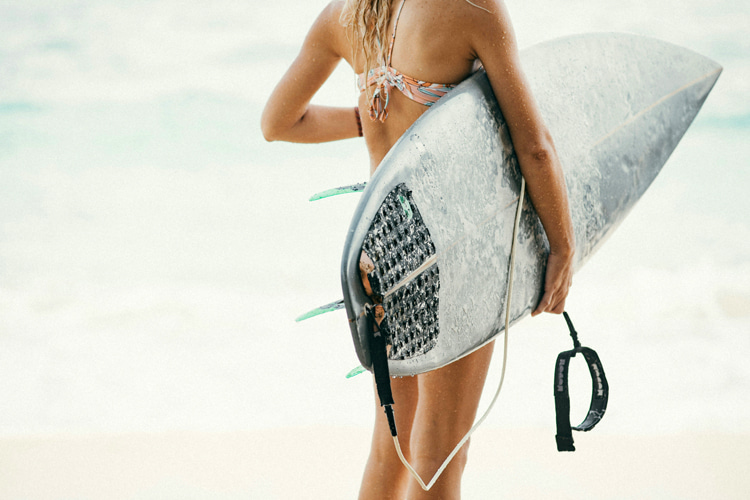
The surfboard leash is made from a stretchy urethane cord attached to a neoprene cuff, and it’s more fragile than it looks.
If you’re paying up to $50 for a durable surfboard leash, you should make sure it lasts a few years. Otherwise, you’re constantly throwing money away.
Although the quality of materials and construction of the kook cord has been evolving since its invention, surfers can easily get unexpected surprises.
This is particularly relevant in more punchy conditions, where legropes are pushed to their limits, with poor maintenance practices on top of it.
We’ve experienced leashes breaking and becoming unusable after a couple of surfs.
So, they will surely not last forever, and the last thing a surfer needs is a leash that fails to do its job in the first minutes of a heavenly session.
How can you ensure you’re doing everything to extend its lifetime? Regular care and simple checks can keep it going above its expected duration.
Here is a list of easy-to-follow surf leash maintenance tips and suggestions.

Rinse with Fresh Water
Rinsing your leash with fresh water after each surf washes off salt, sand, and grit that can eat away at the metal swivel and cord.
The goal is to prevent salt crystals from building up, which can corrode grub screws and weaken the urethane over time.
And this makes even more sense if you’re not taking it back to the water for a week or more.
Dry Thoroughly in a Cool Place
After rinsing, lay your leash out flat in a shaded, well-ventilated spot. Storing it in a cool, dry place stops the cuff and cord from softening or sticking together.
Never stuff a damp leash into your board bag – moisture trapped inside speeds up mildew and material.
Avoid Long Exposure to Direct Sunlight
UV rays are leash killers. Keeping your leash out of direct sun – even when it’s not on your board – prevents the urethane from fading, cracking, or turning brittle.
Storing in the shade or inside a bag helps shield both cord and cuff from heat damage.

Prevent “Memory” by Not Wrapping It Around the Tail
It’s one of the most common and recurring mistakes surfers make around the world.
Wrapping your leash around your board’s tail might look tidy, but it gives the cord a permanent coil (“memory”) that can tangle around your feet in the water.
Another don’t is wrapping the cuff around a fin.
Instead, attach the velcro to the board’s nose or remove it all and hang the leash straight to keep it from kinking.
Inspect the Swivel Joint Before Paddling Out
Before each session, give the swivel (where the cord meets the cuff) a quick pull and spin test.
Look for stiffness or sand build-up that can lock it up and prevent it from rotating naturally.
A free-spinning swivel ensures your board follows you smoothly, not sideways into your legs.
Check for Cracks, Frays, and Loose Velcro
Give your cuff and cord a once-over for tiny cuts, cracks, or fuzzy spots where the urethane is weakening.
Tug on the velcro strap and feel for any places that don’t stick as they should – loose velcro can spell leash loss in a big wave.

Remove Sand and Wax Debris
Salt, sand, or old wax can cling to the cord and cuff.
A quick rinse – and a wipe with a soft cloth – helps clear out abrasive grit that wears parts faster.
Clean the Velcro
Stuck-together debris can dull your velcro. Run an old hair comb through the “hook” side to lift out sand and fuzz – your strap will grip like new.
Keep It Stored Straight
When you’re done surfing, let your leash hang or lie straight rather than rolled up tight.
The trick prevents permanent kinks and tangles when you paddle back out.
Use a Board Bag
A simple board bag not only shields your board but also protects your leash from heat and UV while you travel or store gear at home.
With these easy steps – rinsing, drying, shading, and quick inspections – you’ll stretch every mile out of your leash.
Strap in, paddle out, and let your leash do its job without letting you down.
Words by Luís MP | Founder of SurferToday.com


Leave a Reply